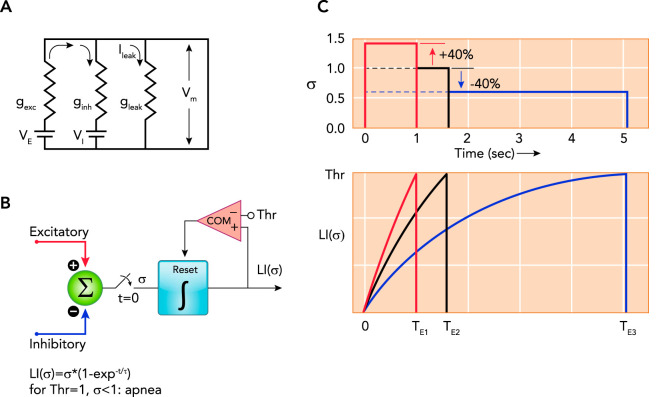FIGURE 2.
Model of the components determining the membrane potential and illustrating the effects of changes in excitatory and/or inhibitory inputs
A: model of the components determining the membrane potential (Vm) of a preBötzinger Complex phase-switching neuron: , where gexc is excitatory conductance, VE is equilibrium potential for excitatory currents, ginh is inhibitory conductance, VI is equilibrium potential for inhibitory currents, and gleak is leak conductance, e.g., GIRK channels (see text for details). B and C: functional timer model to illustrate the effects of changes in excitatory and/or inhibitory inputs on the neuronal membrane trajectory (see Refs. 28, 115, 171–173). B: the sum of all excitatory and inhibitory inputs (σ) is gated to a leaky integrator (LI) at time, t = 0 s. The magnitude of σ determines the rate of the exponential rise of Vm to a threshold (Thr). Crossing the threshold resets the leaky integrator via a comparator (COM). The time to crossing the threshold determines the phase duration. C: graphic illustration of the timing operation using the example of rhythmogenic pre-inspiratory neurons. Neuronal discharge in pre-inspiratory neurons begins when Thr is reached and results in inspiratory on-switch. Inspiratory on-switch terminates the expiratory phase, i.e., the time to Thr for pre-inspiratory neurons determines expiratory duration (TE). Due to the nonlinear nature of this mechanism, increases and decreases in σ of the same magnitude cause strikingly different changes in phase duration. Shown are three examples for σ (upper) and the corresponding leaky integrator outputs LI (σ) (lower). Setting σ = 1.0 as a baseline reference results in a duration of TE2 = 1.6 s (black lines). Increasing σ by 40% results in TE1 = 1 s (red), whereas decreasing σ by 40% results in TE3 = 5 s (blue). Physiological examples for an increase in σ could be an increase in neuronal activity in the parabrachial nucleus (PBN)/Kölliker-Fuse nucleus (137) or an increase in inhibitory activity during the preceding inspiratory phase, which shortens inspiratory duration and presumably shortens the post-inspiratory refractory period (3). The latter could be due to vagal pulmonary stretch receptor input during lung inflation or increased activity of preBötzinger Complex inhibitory neurons during the inspiratory phase (3). Decreases in σ could be due to a reduction in PBN activity via inhibition of PBN neurons by opioids, by increases in pulmonary stretch receptor activity during the expiratory phase (173), or by increases in preBötzinger Complex GABAergic/glycinergic neuronal activity during the expiratory phase (3).

